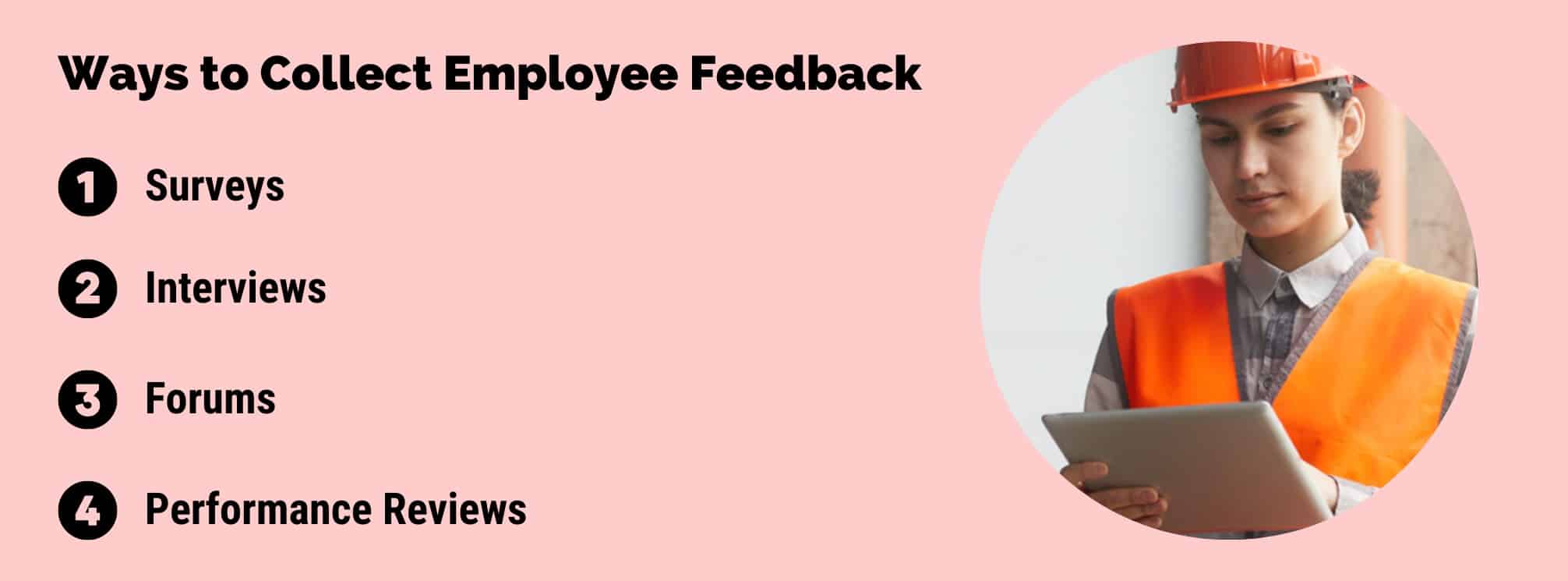
One of the best ways to start improving company culture and retention is to tap into the employee voice. You need to establish that you care about what your employees have to say and are willing to act on employee feedback. Don’t let concerns over survey fatigue, employee burnout, and other fears stop you from making employee feedback part of your strategy. In this blog, we’ll talk about why feedback is so important and 10 best practices for how to gather employee feedback.
There are two types of employee feedback: giving and receiving. In this blog, we’re talking all about receiving feedback from employees to learn about the employee experience.
So, employee feedback is the information employees share with their employer regarding the workforce, their role, their manager, or other parts of their experience.
Often, companies will use employee surveys to gather this feedback. But others use focus groups or one on one interviews.
And the goal of collecting this feedback regularly is to improve the workplace and impact important KPIs like retention, culture, employee engagement, performance, etc.

If you want to collect more employee feedback, there are a variety of ways to do so. Some of these tactics are quick and easy to do and others require more work, but give you a greater level of detail.
Pulse surveys are short polls that typically consist of less than five questions. Because these surveys are so short, they can be used more frequently to collect a “pulse” on a specific topic. For example, if you know that employees are feeling burnt out, you could start a pulse survey series asking employees about their levels of burnout and satisfaction. And you keep asking the same set of questions as you roll out your plan to improve morale and work-life balance.
Long-form surveys, unlike pulse surveys, are used more sparingly and spread apart. That’s because these take longer to complete and ask a wider range of questions. The annual engagement survey is a great example of this method of collecting employee feedback.
Interviewing employees can take many forms. HR and management often use exit interviews and stay interviews to learn more about what makes their workplace great…and not so great. But you can also select a sample of employees to interview about a certain topic. They don’t need to be related to their continued or terminated employment.
One of the easiest ways to collect feedback is to create an employee suggestion box where employees can suggest changes or improvements to the workplace. To make this approach work, however, you need to:
If you’re looking for more detail on a particular topic than a survey will give you, a focus group is a great tactic. These are groups made up of your target audience that you ask questions of to learn more anecdotes and examples behind employee sentiments.
Annual reviews from employees can be a great way to learn more about how they feel about work. This is especially true if your company embraces 360 reviews where employees can review their peers and managers.
An empathy map combines surveys, interviews, focus groups, and observation to create a map of how employees will feel, think, and act in a certain situation. Collecting a large amount of qualitative data can take time and resources to do, but it can be an invaluable tool when navigating a major change or when trying to fix major workplace problems.
[optin-monster slug=”hubylcv3fxywnonrcya9″ followrules=”true”]
So, why is it so important that we take the time to gather feedback from our employees? It’s a lot of work, after all. Why is it worth it?
Although conducting consistent employee surveys and establishing focus groups can take some time upfront to set up, these activities:
So, how do you get better at making two-way feedback a habit? And how do you do it well? These best practices will help.
If you want to ensure your employee feedback plans don’t keep getting pushed off, put them in your editorial calendar. And include other teams in the process of surveying and gathering feedback—one survey can help multiple teams get a sense of how things are going.
So, plan your surveys, interviews, and focus groups ahead of time. And then use your regularly scheduled meeting with stakeholders to involve other departments in the process.
Don’t expect to create focus groups, set up a survey cadence, and get buy-in from leadership overnight. Take it one step at a time.
Maybe start by surveying just one group, like your frontline managers. Pick a group that would be very valuable to learn from.
Start with something manageable and go from there!
You don’t have to have the results of your survey and your plan as soon as your survey closes. But you can’t remain silent for weeks or forever. Like any program, you have to follow up. Plan ahead so you can commit to a timeline.
It might look something like this:
For feedback gathering to really become second nature at your company, you’ll need an executive sponsor. Someone who understands why it’s so important to spend time on these efforts.
It’s your job to prove to leadership why employee feedback is important and convert them into a champion of the employee voice.
Use the results of your employee survey to create benchmarks. Being able to show that historical trend as your feedback program evolves will strengthen your position with leadership. This is a great internal communications best practice that sets you up as a strategic advisor to your company.
To learn more about how to use benchmarks for internal comms, watch this video:
Even if your internal comms team has a few members to review your survey or interview questions, we still recommend you get outside feedback.
We particularly recommend showing the questions to your focus groups—who represent the employee population. This will make sure the questions are worded in a way that makes sense and that you’re including all the right questions.
Don’t just survey to survey.
What are you hoping to learn? And why?
Are you asking the right questions, or are those questions worded in such a way that will give you helpful feedback?
Make sure everything you’re asking comes back to a goal or initiative you can act on. Otherwise, you’ll be collecting information you can’t do anything with.
You want to make sure it is easy for your employees to participate—remember you’re getting feedback from hourly team members and field managers. They’re busy too!
Keep your employees in mind when you write surveys or invite them to participate in an interview or focus group.
Put your writer’s hat on and get out that red pen. Are the questions written as clearly as they can be? Have you thought about whether all the questions are necessary? Are there questions that are missing? Do you need some if/then logic added to the survey to clarify certain responses?
If you work at a larger enterprise, you likely have a resident expert on surveying and research. Tap into that expertise and partner with them.
But if you work at a smaller company that doesn’t have this kind of internal resource, consult the templates that exist on most major survey platforms. There is a wealth of information out there that can help you write great surveys. Like this free ebook on measurement and surveys, for example.
At theEMPLOYEEapp, we integrate with major survey platforms to create a seamless employee survey experience. And that’s the next major key to launching a successful survey or two-way feedback initiative: making it accessible.
If you take just one of the internal communications best practices away from this it’s that. You’ll never get the data or the feedback you need from the frontlines of your organization if they aren’t getting your messages in the first place.
Want to learn how theEMPLOYEEapp may be able to help? Request a demo today.
[optin-monster slug=”gqorn0natkqgyrtjvr6i” followrules=”true”]
Sydney Lauro is the Demand Generation Manager for theEMPLOYEEapp. Prior to joining the team at theEMPLOYEEapp, Sydney worked in internal communications for Chipotle. She uses her internal comms expertise and passion for improving communication and the employee experience to create content and share best practices to help other communications professionals.